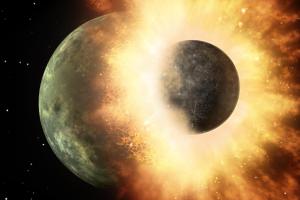Blog
Hit Me With
Your Best Shot
10 April 2015
 NASA/JPL-Caltech
NASA/JPL-CaltechOne of the striking features of Earth (besides the living things upon it) is that it possesses a relatively large moon. While our Moon is not the largest in the solar system, it is large for such a small planet. The mass of the Moon is more than 1% that of Earth, compared to Jupiter’s largest moon Ganymede, which is just 0.008% of Jupiter’s mass. The origin of our large moon has been a matter of some debate.
The most popular model is the collision model. In this model, the young proto-Earth collided with a Mars-sized planetoid sometimes named Theia. Part of the mass of Theia was captured to become Earth, and the remains formed a debris ring around Earth, much of which coalesced to form the Moon. This model has a lot going for it. For example, the Moon has a density about 60% that of Earth, which is exactly what is predicted by the collision model, where the lighter outer layers of Theia and proto-Earth are scattered to the debris disk, while the heavy core of proto-Earth remains.
The main downside of this model is the fact that the Earth and Moon have a very similar chemical composition. The only way to explain that fact with the collision model is to assume that Theia and Earth had a very similar composition, which would seem unlikely. Now new research published in Nature has found that similarities between colliding bodies aren’t as unlikely as we thought.1
The team ran computer simulations of young solar systems, and looked at how chemically similar large bodies were with their last major impactors. What they found was that 20% – 40% of the time they were similar enough to account for the Earth-Moon compositions. So it’s not so unusual that the Earth and Moon are chemically similar.
There’s only one other body in the solar system with such a relatively large moon as ours, and that’s Pluto’s moon Charon. Charon’s mass is 12% that of Pluto. Charon is also thought to be the result of a collision, so when New Horizons makes its flyby of the planet in July, we find even more clues about planet-shattering collisions.
Mastrobuono-Battisti, Alessandra, Hagai B. Perets, and Sean N. Raymond. “A primordial origin for the compositional similarity between the Earth and the Moon.” Nature 520.7546 (2015): 212-215. ↩︎